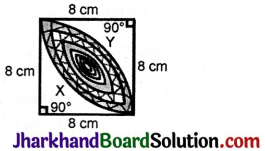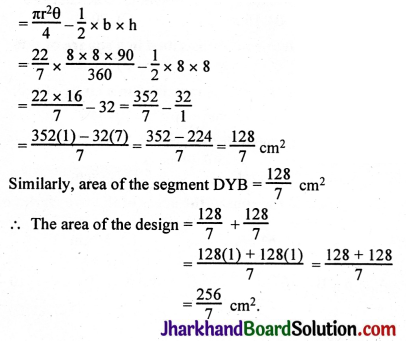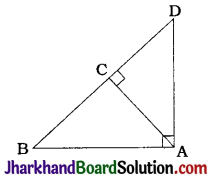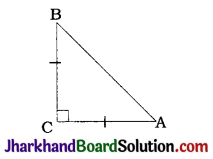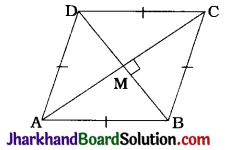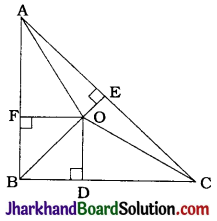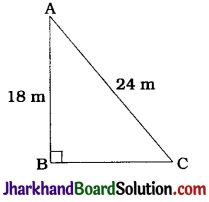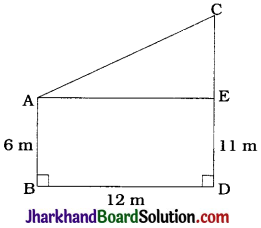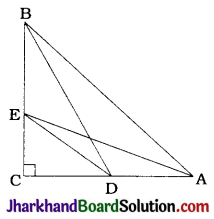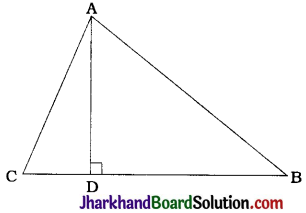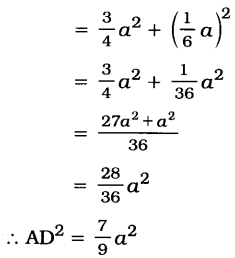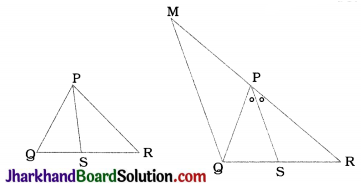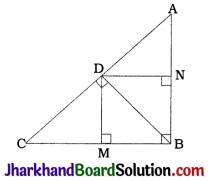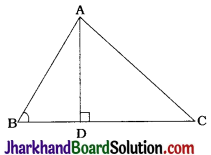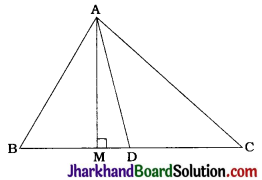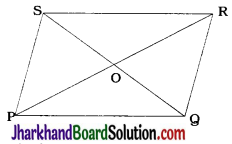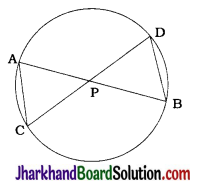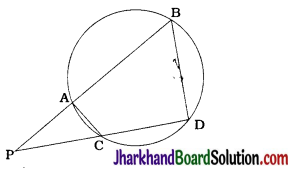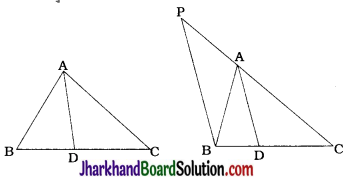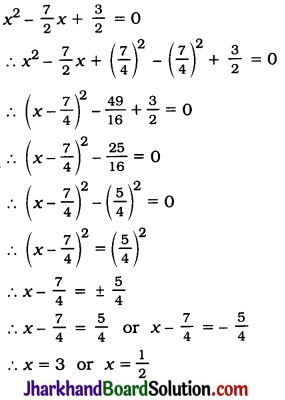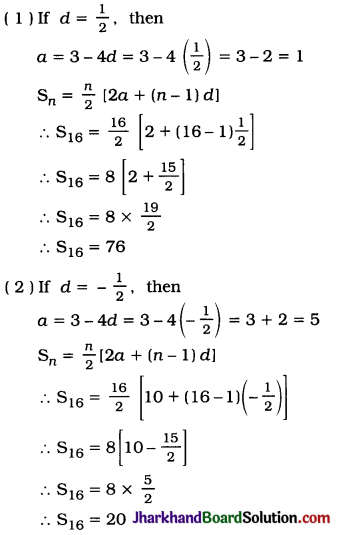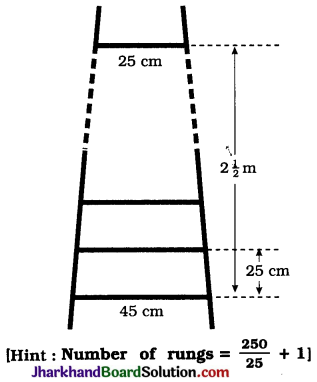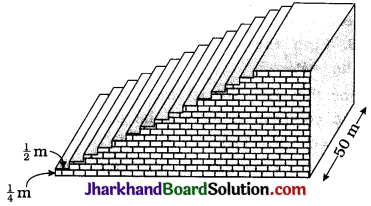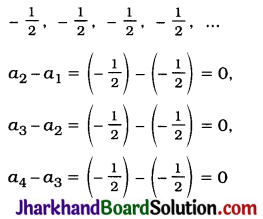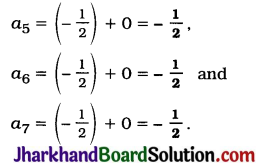Jharkhand Board JAC Class 10 Sanskrit Solutions Shemushi Chapter 12 अन्योक्तयः Textbook Exercise Questions and Answers.
JAC Board Class 10th Sanskrit Solutions Shemushi Chapter 12 अन्योक्तयः
JAC Class 10th Sanskrit अन्योक्तयः Textbook Questions and Answers
प्रश्न 1.
एकपदेन उत्तरं लिखत (एक शब्द में उत्तर लिखिए)
(क) कस्य शोभा एकेन राजहंसेन भवति?
(किसकी शोभा एक राजहंस से होती है?)
उत्तरम् :
सरसः (सरोवर की)।
(ख) सरसः तीरे के वसन्ति?
(तालाब के किनारे कौन रहते हैं?)
उत्तरम् :
वकसहस्रम् (हजारों बगुले)।

(ग) कः पिपासः प्रियते?
(कौन प्यासा मर जाता है?)
उत्तरम् :
चातकः (पपीहा)।
(घ) के रसाल मुकुलानि समाश्रयन्ते ?
(आम की मंजरियों का आश्रय कौन लेते हैं ?)
उत्तरम् :
भृङ्गाः (भौरे)।
(ङ) अम्भोदाः कुत्र सन्ति? (बादल कहाँ हैं?)
उत्तरम् :
गगने (आकाश में)।
प्रश्न 2.
अधोलिखितानां प्रश्नानाम् उत्तराणि संस्कृतभाषया लिखत
(नीचे लिखे प्रश्नों के उत्तर संस्कृत भाषा में लिखिए)
(क) सरसः शोभा केन भवति ?
(तालाब की शोभा किससे होती है ?)
उत्तरम् :
सरसः शोभा एकेन एव राजहंसेन भवति।
(तालाब की शोभा एक ही राजहंस से होती है।)

(ख) चातकः किमर्थं मानी कथ्यते ?
(चातक किस अर्थ में स्वाभिमानी है?)
उत्तरम् :
चातकः तृषितः मरणम् आप्नोति परञ्च सर्वान् वारिदान् न याचते, केवलं पुरन्दरं याचते।
(चातक प्यासा मर जाता है, लेकिन अन्य बादलों से नहीं माँगता, केवल इन्द्र से माँगता है।)
(ग) मीनः कदा दीनां गतिं प्राप्नोति ?
(मछली कब दीन गति को प्राप्त होती है ?)
उत्तरम् :
यदा सरः सङ्कोचमञ्चति तदा मीन: दीनां गतिं प्राप्नोति।
(जब तालाब सूख जाता है तब मछली दीन दशा को प्राप्त होती है।)
(घ) कानि पूरयित्वा जलदः रिक्तः भवति ?
(किन्हें भरकर बादल खाली हो जाता है ?)
उत्तरम् :
नानानदीनदशतानि पूरयित्वा जलदः रिक्तः भवति।
(अनेक नदी और सैकड़ों नदों को भरकर बादल खाली हो जाता है।)
(ङ) वृष्टिभिः वसुधां के आर्द्रयन्ति ?
(वर्षा से धरती को कौन गीला कर देते हैं ?)
उत्तरम् :
अम्भोदाः वृष्टिभिः वसुधां आर्द्रयन्ति।
(बादल वर्षा से धरती को गीला कर देते हैं।)

प्रश्न 3.
अधोलिखितवाक्येष रेखाकितपदानि आधुत्य प्रश्ननिर्माणं करुत –
(निम्नलिखित वाक्यों में रेखांकित पदों के आधार पर प्रश्न निर्माण कीजिए)
(क) मालाकारः तोयैः तरोः पुष्टिं करोति।
(माली जल से वृक्ष का पोषण करता है।)
उत्तरम् :
मालाकार: कैः तरोः पुष्टिं करोति ?
(माली किनसे वृक्ष का पोषण करता है ?)
(ख) भृङ्गाः रसालमुकुलानि समाश्रयन्ते।
(भौरे आम के बौर का आश्रय लेते हैं।)
उत्तरम् :
भृङ्गाः कानि समाश्रयन्ते ?
(भौरे किनका आश्रय लेते हैं ?)
(ग) पतङ्गाः अम्बरपथम् आपेदिरे।
(पक्षियों ने आकाश मार्ग पाया।)
उत्तरम् :
के अम्बरपथं आपेदिरे ?
(किन्होंने आकाश मार्ग पाया ?)
(घ) जलदः नानानदीनदशतानि पूरयित्वा रिक्तोऽस्ति।
(बादल अनेक नदी और सैकड़ों नदों को भरकर खाली है।)
उत्तरम् :
कः नानानदीनदशतानि पूरयित्वा रिक्तोऽस्ति ?
(कौन अनेक नदी और सैकड़ों नदों को भरकर खाली है ?)

(ङ) चातकः वने वसति। (पपीहा वन में रहता है।)
उत्तरम् :
चातकः कुत्र वसति ? (पपीहा कहाँ रहता है ?)
प्रश्न 4.
अधोलिखितयो श्लोकयोः भावार्थ संस्कृतभाषया लिखत –
(निम्नलिखित श्लोकों का भावार्थ संस्कृत भाषा में लिखिये)
(अ) तोयैरल्पेरपि ………… वारिदेन।।
उत्तरम् :
भावार्थ – सुयोग्यः समर्थः एव व्यक्ति कार्य सम्यग् रूपेण सम्पादयितुं शक्नोति। यथा हि कवि पण्डित राज कथयति-‘रे उद्यानपाल! यं वृक्षं त्वं सकरुणं प्रचण्ड ग्रीष्म? अल्पैः जलै, अर्थात् आवश्यकतानुसारमसिञ्चः, एवम् असौ वृक्षः शनैः पालितः, किं तत् कार्यम् समर्थोऽसन् वृष्टिः धारा प्रवाहेण प्रभूतेन जलेन कर्तुं शक्नोति।
यथावश्यकमेव पोषणम् अपेक्ष्यते।’ (सुयोग्य और समर्थ व्यक्ति ही कार्य सुचारु रूप से सम्पन्न कर सकता है। जैसा कि कवि पण्डितराज कहते हैं- ‘हे माली! जिस वृक्ष को तुमने करुणा के साथ प्रचण्ड ग्रीष्म ऋतु में आवश्यकतानुसार थोड़ा-थोड़ा पानी देकर पाला था, क्या इस कार्य में समर्थ होते हुये भी वर्षा (अनावश्यक) बहुत से धारा प्रवाह जल से कर सकता है। सभी यथावश्यक पोषण की अपेक्षा करते हैं।)
(आ) रे रे चातक ………………….. दीनं वचः।
भावार्थ: – श्लोकेऽस्मिन् कवि चातकस्य माध्यमेन कथयति यत् सर्वे धनिकाः समृद्धाः वा जनाः दातारः न भवन्ति अतः यं कञ्चित् मानवं मा याचनां कुरु यथा हि कविः भर्तहरि कथयति – ‘रे रे चातक! सावहितः सन् शृणु मित्र। आकाशे अनेके मेघाः आयान्ति यान्ति च परञ्च तेषु केचनैव वर्षन्ति। एवं एव संसारे अनेके धनिका समृद्धाः च मानवा आयान्ति यान्ति च। तेषु केचन यच्छन्ति अन्ये तु व्यर्थमेव आत्मानं प्रदर्शयन्ति। अतोऽहं ब्रवीमि यत् त्वम यं कञ्चनं पश्यति तस्य सम्मुखं याचनाय मा गच्छ। सु दानभावोपेतं जनं ज्ञात्वा एवं याचनाय हस्तौ प्रसारय।
यथा सर्वे वारिदाः चातकाय स्वाति बिन्दुं न दातुं शक्नोति तथैव सर्वे जनाः याचकाय दान न दातुं शक्नुवन्ति। (इस श्लोक में कवि चातक के माध्यम से कहता है कि सभी धनवान या समद्ध लोग दानदाता नहीं होते। अतः जिस किसी मानव से मत याचना करो। जैसा कि कवि भर्तृहरि कहता है-‘ओ चातक! सावधान होकर सुन। मित्र! आकाश में अनेक मेघ आते हैं और चले जाते हैं। उनमें से कुछ ही देते हैं अन्य तो व्यर्थ ही अपना दिखावा करते हैं। अतः मैं चाहता हूँ कि तुम जिस किसी को देखो उसी के सामने याचना के लिये मत जाओ। (अच्छे दान भाव से युक्त व्यक्ति को जानकर याचना के लिये हाथ फैलाओ। जैसे सभी बादल चातक को स्वाति की बूंद नहीं दे सकते हैं वैसे ही सभी लोग याचक को दान नहीं दे सकते हैं।)

प्रश्न 5.
अधोलिखित श्लोकयोः अन्वयं लिखत। (निम्नलिखित श्लोकों का अन्वय लिखो)
(अ) आपेदिरे …………. कतमां गतिमभ्युपैति।
अन्वयः – पतङ्गाः परितः अम्बरपथम् आपेदिरे, भृङ्गाः रसाल मुकलानि समाश्रयन्ते। सरः त्वयि सङ्कोचम् अञ्चति, हन्त दीन-दीनः मीनः नु कतमां गतिम् अभ्युपैतु।
(आ) आश्वास्य ………….. सैवतवोत्तमा श्रीः।।
अन्वयः – तपनोष्णतप्तम् पर्वतकुलम् आश्वास्य उदाम दावविधुराणि काननानि च आश्वास्य नाना नदी गतानि पूरयित्वा च हे जलद। यत् रिक्तः असि तव सा एव उत्तमा श्रीः।
प्रश्न 6.
उदाहरणमनुसृत्य सन्धिं/सन्धिविच्छेदं वा कुरुत –
(उदाहरण के अनुसार सन्धि/सन्धि-विच्छेद कीजिए)
(i) यथा – अन्य + उक्तयः = अन्योक्तयः।
(क) …………. + ………….. = निपीतान्यम्बूनि।
(ख) …………. + उपकारः = कृतोपकारः।
(ग) तपन + …………… = तपनोष्णतप्तम्।
(घ) तव + उत्तमा = …………………।
(ङ) न + एतादृशाः = …………………।
उत्तरम् :
(क) निपीतानि + अम्बूनि = निपीतान्यम्बूनि।
(ख) कृत + उपकारः = कृतोपकारः।
(ग) तपन + उष्णतप्तम् = तपनोष्णतप्तम्।
(घ) तव + उत्तमा = तवोत्तमा।
(ङ) न + एतादृशाः = नैतादृशाः।

(ii) यथा – पिपासितः + अपि = पिपासितोऽपि।
(क) ……………. + ……………… = कोऽपि।
(ख) ……………. + ………………. = रिक्तोऽसि।
(ग) मीनः + अयम् = ………………।
(घ) सर्वे + आदि = …………
उत्तरम् :
(क) कः + अपि = कोऽपि।
(ख) रिक्तः + असि = रिक्तोऽसि।
(ग) मीनः + अयम् = मीनोऽयम्।
(घ) सर्वे + ऽपि = ………………..
(iii) यथा – सरस: + भवेत् = सरसोभवेत्।
(क) खगः + मानी – ……………।
(ख) …………. + नु = मीनो नु।
(ग) पिपासितः + वा = ………..।
(घ) …………. + ………. = पुरुतोमा।
उत्तरम् :
(क) खगः + मानी = खगो मानी।
(ख) मीनः + नु = मीनो नु।
(ग) पिपासितः + वा = पिपासितोवा।
(घ) पुरतः + मा = पुरुतोमा।
(iv) यथा – मुनिः + अपि = मुनिरपि।
(क) तोयैः + अल्पैः = …………..।
(ख) ………… + अपि = अल्पैरपि।
(ग) तरोः + अपि = ………………।
(घ) ………. + आर्द्रचन्ति = वृष्टिमिरार्द्रयन्ति।
उत्तरम् :
(क) तोयैः + अल्पैः = तोयैरल्पैः
(ख) अल्पैः + अपि = अल्पैरपि
(ग) तरोः + अपि = तरोरपि।
(घ) वृष्टिमिः + आर्द्रयन्ति = वृष्टिमिरार्द्रयन्ति।

प्रश्न 7.
उदाहरणमनुसृत्य अधोलिखितैः विग्रहपदैः समस्तपदानि रचयत –
(उदाहरण के अनुसार निम्नलिखित विग्रह पदों से समस्त पद बनाइए)

JAC Class 10th Sanskrit अन्योक्तयः Important Questions and Answers
शब्दार्थ चयनम् –
अधोलिखित वाक्येषु रेखांकित पदानां प्रसङ्गानुकूलम् उचितार्थ चित्वा लिखत –
प्रश्न 1.
एकेन राजहंसेन या शोभा सरसो भवेत्।
(अ) तडागस्य
(ब) कटु
(स) सरसः
(द) जलदः
उत्तरम् :
(अ) तडागस्य
प्रश्न 2.
न सा. बकसहस्रेण परितस्तीरवासिना।
(अ) भवेत्
(ब) अभितः
(स) शृगालः
(द) भवति
उत्तरम् :
(ब) अभितः

प्रश्न 3.
भुक्ता मृणालपटली भवता निपीता।
(अ) भवता
(ब) युक्ता
(स) खादिता
(द) अम्बूनि
उत्तरम् :
(स) खादिता
प्रश्न 4.
न्यम्बूनि यत्र नलिनानि निषेवितानि।
(अ) राजहंस
(ब) सरोवरस्य
(स) भविता
(द) सेवितानि
उत्तरम् :
(द) सेवितानि
प्रश्न 5.
तोवैरल्यैरपि करुणया भीमभानौ निदाघे।
(अ) ग्रीष्मकाले
(ब) भानवेः
(स) निर्दय
(घ) भवता
उत्तरम् :
(अ) ग्रीष्मकाले
प्रश्न 6.
व्यरचि भवता या तरोरस्य पुष्टिः।
(अ) विश्वतः
(ब) कृता
(स) जनयितुम्
(द) शक्या
उत्तरम् :
(ब) कृता

प्रश्न 7.
भृङ्गा रसालमुकुलानि समाश्रयन्ते।
(अ) आपेदिरे
(ब) समाश्रयन्ते
(स) द्विरेफा
(द) दीनदीनः
उत्तरम् :
(स) द्विरेफा
प्रश्न 8.
एक एव खगो मानी वने वसति चातकः।
(अ) पिपासितः
(ब) पुरन्दरम्
(स) याचते
(द) स्तोककः
उत्तरम् :
(द) स्तोककः
प्रश्न 9.
यं यं पश्यसि तस्य तस्य पुरतो मा ब्रूहि दीनं वचः।
(अ) वद
(ब) बहवः
(स) आर्द्रयन्ति
(द) पश्यसि
उत्तरम् :
(अ) वद
प्रश्न 10.
नानानदीनदशतानि च पूरयित्वा।
(अ) पूर्णिमाया
(ब) पूरणी:
(स) आश्वास्य
(द) पूर्णं कृत्वा
उत्तरम् :
(स) आश्वास्य
संस्कृतमाध्यमेन प्रश्नोत्तराणि –
एकपदेन उत्तरत (एक शब्द में उत्तर दीजिए)
प्रश्न 1.
राजहंसोऽत्र कस्य प्रतीकः ?
(राजहंस यहाँ किसका प्रतीक है ?)
उत्तरम् :
सज्जनस्य (सज्जन का)।

प्रश्न 2.
कविः ‘बकसहस्रम्’ कं कथयति ?
(कवि ‘बकसहस्रम्’ किसे कहता है ?)
उत्तरम् :
मूर्खान् (मूरों को)।
प्रश्न 3.
मालाकारेण तरोः पुष्टिः कैः कृता ?
(माली ने वृक्ष का पोषण किनसे किया ?)
उत्तरम् :
तोयैः (जल से)।
प्रश्न 4.
मालाकारः कथं तोयैः वृक्षस्य पुष्टिः व्यरचि ?
(माली ने किस प्रकार पानी से वृक्ष की पुष्टि की ?)
उत्तरम् :
करुणया (करुणा से)।
प्रश्न 5.
सङ्कचिते सरोवरे पतङ्गाः कुत्र आपेदिरे ?
(सरोवर के सूख जाने पर पक्षी कहाँ गये ?)
उत्तरम् :
अम्बरपथम् (आकाश मार्ग में)।
प्रश्न 6.
कीदृशः चातकः पिपासितो म्रियते ?
(कैसा चातक प्यासा मरता है ?)
उत्तरम् :
मानी (स्वाभिमानी)।

प्रश्न 7.
कविः कं सम्बोध्य श्लोकं अरचयत् ?
(कवि किसको संबोधित करके श्लोक की रचना करता है?)
उत्तरम् :
मेघः (बादल)।
प्रश्न 8.
काननानि कः आश्वास्यति ?
(जंगलों को कौन आश्वस्त करता है ?)
उत्तरम् :
जलदः (बादल)।
प्रश्न 9.
कविः मित्रः इति शब्देन के सम्बोधयति ?
(कवि ‘मित्र’ इस शब्द से किसको संबोधित करता है?)
उत्तरम् :
चातकः (पपीहा को)।
प्रश्न 10.
केचिद् अम्भोदाः कथं गर्जन्ति ?
(कुछ बादल कैसे गर्जते हैं ?)
उत्तरम् :
वृथा (व्यर्थ ही)।
प्रश्न 11.
एकेन राजहंसेन कस्य शोभा भवेत् ?
(एक हंस से किसकी शोभा होती है?)
उत्तरम् :
सरसः (तालाब की)।

प्रश्न 12.
सरसः तीरवासिनः के सन्ति ?
(तालाब के किनारे वास करने वाले कौन हैं ?)
उत्तरम् :
बकसहस्रम् (हजारों बगुले)।
प्रश्न 13.
मृणालपटली केन भुक्ता ?
(कमलनालों का समूह किसके द्वारा खाया गया है ?)
उत्तरम् :
राजहंसेन (राजहंस के द्वारा)।
प्रश्न 14.
राजहंसेन कानि निपीतानि ?
(राजहंस ने किन्हें पीया ?)
उत्तरम् :
अम्बूनि (जल)।
प्रश्न 15.
तरोः पुष्टिः केन कृतः ?
(वृक्ष का पोषण किसके द्वारा किया गया है ?)
उत्तरम् :
मालाकारेण (माली द्वारा)।

प्रश्न 16.
मालाकारेण तरोः कदा पुष्टिः कृता ?
(माली ने वृक्ष का पोषण कब किया ?)
उत्तरंम् :
निदाघे (गर्मी में)।
प्रश्न 17.
सङ्कुचिते सरोवरे परितः अम्बरपथं कः आपेदिरे ?
(सरोवर के सूख जाने पर चारों ओर आकाशमार्ग को कौन प्राप्त कर लेते हैं ?)
उत्तरम् :
पतङ्गाः (पक्षी)।
प्रश्न 18.
रसालमुकुलानि के समाश्रयन्ते ?
(आम की मजरी को आश्रय कौन लेते हैं ?)
उत्तरम् :
भृङ्गाः (भौरे)।
प्रश्न 19.
एकः एव मानी वने कः वसति ?
(एक ही स्वाभिमानी वन में कौन निवास करता है ?)
उत्तरम् :
खगः (पक्षी)।

प्रश्न 20.
पुरन्दरात् कः याचते ?
(इन्द्र से कौन माँगता है ?)
उत्तरम् :
चातकः (पपीहा)।
प्रश्न 21.
कः नदी नद शतानि पूरयति ?
(कौन सैकड़ों नद-नदियों को भर देता है ?)
उत्तरम् :
जलदः (बादल)।
प्रश्न 22.
तपनोष्णतप्तम् किम् ?
(सूर्य की गर्मी से कौन तपी है ?)
उत्तरम् :
पर्वतकुलम् (पर्वतों के समूह)।
प्रश्न 23.
के वृष्टिभः वसुधां आर्द्रयन्ति ?
(कौन बरसकर धरती को गीला कर देते हैं ?)
उत्तरम् :
अम्भोदाः (बादल)।

प्रश्न 24.
कीदृशं वचः मा ब्रूहिः ?
(कैसे वचन मत बोलो?)
उत्तरम् :
दीनंवचः (दीन वचन)।
पूर्णवाक्येन उत्तरत (पूरे वाक्य में उत्तर दीजिए)
प्रश्न 25.
कृतोपकारः कः भविष्यति ?
(उपकार करने वाला कौन होगा ?)
उत्तरम् :
कृतोपकारः राजहंसः भविष्यति।
(उपकार करने वाला राजहंस होगा।)
प्रश्न 26.
धारासारान् कः विकिरति।
(जलधाराओं को कौन बरसाता है ?)
उत्तरम् :
धारासारान् वारिदः विकिरति।
(जलधाराओं को बादल बरसाता है।)

प्रश्न 27.
चातकः मानी कथम् ?
(चातक मानी कैसे है ?)
उत्तरम् :
चातकः पिपासितो म्रियते पुरन्दरम् वा याचते।
(चातक या तो प्यासा मरता है या इन्द्र से याचना करता है।)
प्रश्न 28.
जलदः कान् पूरयति ? (बादल किनको भरता है?)
उत्तरम :
जलदः नानानदीनदशतानि पूरयति।
(बादल अनेक नदी और सैकड़ों नदों को भरता है।)
प्रश्न 29.
कविः श्रोतारं किं कारणाद् वर्जयति?
(कवि श्रोताओं को किस कारण रोकता है?)
उत्तरम् :
कवि श्रोतारं वर्जयति-मा ब्रूहि दीनं वचः
(कवि सुनने वालों को रोकता है–किसी के सामने दीन वचन मत बोलो)।
प्रश्न 30.
सरसः शोभा केन न भवति ?
(तालाब की शोभा किससे नहीं होती ?)
उत्तरम् :
सरसः शोभा परितः तीरवासिना बकसहस्रेण न भवति।
(तालाब की शोभा चारों ओर किनारे पर बैठे हजारों बगलों से नहीं होती।)

प्रश्न 31.
राजहंसेन कानि निषेवितानि ?
(राजहंस द्वारा किनका सेवन किया गया ?)
उत्तरम् :
राजहंसेन नलिनानि निषेवितानि।
(राजहंस ने कमलनालों का सेवन किया।)
प्रश्न 32.
मालाकार: केन प्रकारेण तरोः पुष्टिं करोति ?
(माली किस प्रकार से वृक्ष की पुष्टि करता है ?)
उत्तरम् :
मालाकार: निदाघे अल्पैः तोयैः अपि करुणया तरोः पुष्टिं करोति।
(माली गर्मी में थोड़े जल से भी करुणा के साथ वृक्ष का पोषण करता है।)
प्रश्न 33.
सरोवरे सङ्कुचिते भृङ्गाः कानि समाश्रयन्ते ?
(सरोवर के सूख जाने पर भौरे किनका आश्रय ले लेते हैं?)
उत्तरम् :
सरोवरे सङ्कुचिते भृङ्गाः रसालमुकुलानि समाश्रयन्ते।
(सरोवर के सूख जाने पर भौरे आम की मंजरी का आश्रय ले लेते हैं।)

प्रश्न 34.
वने कः वसति ?
(वन में कौन रहता है ?)
उत्तरम् :
वने एकः मानी खगः चातकः वसति।
(वन में एक स्वाभिमानी पक्षी चातक रहता है।)
प्रश्न 35.
जलदः कीदृशानि काननानि आवश्स्य रिक्तो भवति ?
(बादल वनों को किस प्रकार आश्वस्त करके जलहीन (खाली) हो जाता है?)
उत्तरम् :
जलदः रिक्तोभवति उद्दामदावविधुराणि काननानि आश्वस्तं करोति।
(बादल खाली होकर दावाग्नि से नष्ट हुए वनों को आश्वस्त करता है।)
प्रश्न 36.
कवि के सम्बोध्य श्लोकं कथयति ?
(कवि श्लोक किसको सम्बोधित करके कहता है?)
उत्तरम् :
कवि चातकः सम्बोध्य श्लोक कथयति।
(कवि श्लोक चातक को सम्बोधित करके कहता है।
अन्वय-लेखनम् –
अधोलिखितश्लोकस्यान्वयमाश्रित्य रिक्तस्थानानि मञ्जूषातः समुचितपदानि चित्वा पूरयत।
(नीचे लिखे श्लोक के अन्वय के आधार पर रिक्तस्थानों की पूर्ति मंजूषा से उचित पद चुनकर कीजिए।)
1. एकेन ……….. ………… तीरवासिना।। .
मञ्जूषा – तीरवासिना, राजहंसेन, सा, शोभा।
एकेन (i) …………. सरस: या (ii) …………. भवेत् परितः (iii) …………. बकसहस्रेण (iv) …………. (शोभा) न (भवति)।
उत्तरम् :
(i) राजहंसेन (ii) शोभा (iii) तीरवासिना (iv) सा।

2. भुक्ता …………………. कृतोपकारः।।
मञ्जूषा – निषेवितानि, अम्बूनि, मृणालपटली, कृतोपकारः।
यत्र भवता (i) ………… भुक्ता, (ii) ………… निपीतानि नलिनानि (iii) ………… रे राजहंस ! तस्य सरोवरस्य केन कृत्येन (iv) …………. भविता असि, वद।
उत्तरम् :
(i) मृणालपटली (ii) अम्बूनि (iii) निषेवितानि (iv) कृतोपकारः।
3. तोयैरल्पैरपि………………………. वारिदेन।।
मञ्जूषा – प्रावृषेण्येन, भीमभानौ, विकिरता, करुणया।
हे मालाकार ! (i) …………. निदाघे अल्पैः तोयैः अपि भवता (ii) …………. अस्य तरोः या पुष्टिः व्यरचि। वारां (iii) …………. विश्वतः धारासारान् अपि (iv) …………. वारिदेन इह जनयितुं सा किं शक्या।
उत्तरम् :
(i) भीमभानौ (ii) करुणया (iii) प्रावृषेण्येन (iv) विकिरता।
4. आपेदिरेऽम्बरपथं ………………… गतिमभ्युपैतु।।
मञ्जूषा – कतमां, भृङ्गाः, परितः, अञ्चति। (सङ्कुचिते सरोवरे)
पतङ्गाः (i) …………. अम्बरपथम् आपेदिरे, (ii) …………. रसालमुकुलानि समाश्रयन्ते। सरः त्वयि सङ्कोचम् (iii) …………., हन्त दानदान: मीनः नु (iv) ………….गतिम् अभ्युपतु।।
उत्तरम् :
(i) परितः (ii) भृङ्गाः (iii) अञ्चति (iv) कतमां।
5. एक एव खगो ……………………….. पुरन्दरम्।।
मञ्जूषा – पुरन्दरं, चातकः, एव, पिपासितः।
एक: (i) ……….. मानी खगः (ii) ……….. वने वसति वा (iii) ……….. म्रियते (ii) ………… याचते।।
उत्तरम् :
(i) एव (ii) चातकः (iii) पिपासितः (iv) पुरन्दरं।।
6. आश्वास्य पर्वतकुलं ……….. …… तवोत्तमा श्रीः।।
मञ्जूषा – काननानि, पर्वतकुलम्, उत्तमा, जलद।
तपनोष्णतप्तम् (i) ……….. आश्वास्य उद्दामदावविधुराणि (ii) ……….. च (आश्वास्य) नानानदीनदशतानि पूरयित्वा च हे (ii) ……….. ! यत् रिक्तः असि तव सा एव (ii) ……….. श्रीः।
उत्तरम् :
(i) पर्वतकुलम् (ii) काननानि (iii) जलद (iv) उत्तमा।

7. रे रे चातक ! ……………………….. दान …….. दीनं वचः।।
मञ्जूषा – एतादृशाः, अम्भोदाः, श्रूयताम, आर्द्रयन्ति।
रे रे मित्र चातक ! सावधानमनसा क्षणं (i) …………. गगने हि बहवः (ii) …………. सन्ति, सर्वेऽपि (iii) … ” ………. न (सन्ति) केचित् वसुधां वृष्टिभिः (iv) …………. केचित् वृथा गर्जन्ति, यं यं पश्यसि तस्य तस्य पुरतः दीनं वचः मा ब्रूहि।
उत्तरम् :
(i) श्रूयताम् (ii) अम्भोदाः (iii) एतादृशाः (iv) आर्द्रयन्ति।
प्रश्ननिर्माणम् –
अधोलिखित वाक्येषु स्थूलपदमाधृत्य प्रश्ननिर्माणं कुरुत –
1. सरसः शोभा राजहंसेन भवेत्.। (तालाब की शोभा राजहंस से होनी चाहिए।)
2. राजहंसेन सरोवरस्य नलिनानि निषेवितानि। (राजहंस द्वारा सरोवर के कमलनालों का सेवन किया गया।)
3. भृङ्गाः रसालमुकुलानि समाश्रयन्ते। (भौरे आम के बौर का आश्रय लेते हैं।)
4. पतङ्गाः परितः अम्बरपथं आपेदिरे। (पक्षी चारों ओर आकाश में पहुँच गए।)
5. सरसि संकोचम् अञ्चति मीन: दु:खीभवति। (तालाब के सूख जाने पर मछली दःखी होती है।)
6. मानी चातकः वने वसति। (स्वाभिमानी चातक वन में रहता है।)
7. चातक: पुरन्दरं याचते। (पपीहा इन्द्र से याचना करता है।)।
8. जलदः तपनोष्णतप्तं पर्वतकुलम् आश्वासयति। (बादल सूर्य से सन्तप्त पर्वत समूहों को आश्वस्त करता है।) .
9. जलदः नानानदीनदशतानि पूरयित्वा रिक्तो भवति। (बादल सैकड़ों नदी-नदों को भरकर रिक्त होता है।)
10. वारिदाः वृष्टिभिः वसुधाम् आर्द्रयन्ति। (बादल वर्षा से धरती को गीला करते हैं।)
उत्तराणि :
1. सरसः शोभा केन भवेत् ?
2. राजहंसेन सरोवरस्य कानि निषेवितानि ?
3. भृङ्गाः कानि समाश्रयन्ते ?
4. पतङ्गाः परितः कम् आपेदिरे ?
5. सरसि सङ्कोचमञ्चति कः दुःखी भवति ?
6. मानी चातकः कुत्र वसति ?
7. चातकः कम् याचते ?
8. जलदः के आश्वासयति ?
9. जलदः कानि पूरयित्वा रिक्तो भवति ?
10. वारिदाः काभिः वसुधाम् आर्द्रयन्ति ?

भावार्थ-लेखनम् –
अधोलिखित पद्यांश संस्कृते भावार्थ लिखत –
1. एकेन राजहंसेन या ………………………. परितस्तीरवासिना।।
भावार्थ – एकेन मरालेन सरोवरस्य सौन्दर्य स्मात् परञ्च अभितः तट उषितैः सहस्रवकैः सा शोभा न सम्भवति।
2. भुक्ता मृणालपटली भवता …………………………… भवितासि कृतोपकारः।।
भावार्थ – यस्मिन् स्थाने त्वया श्रीमता कमलनाल समूह खादितः नि:शेषाणि जलानि पीतानि कमलानां सेवनं कृतम् रे मराल! अमुष्य तडागस्य केन कार्येण तस्य हितकारकः भविष्यसि (कथं तस्योपकारं करिष्यसि) कथय कथं भविष्यति।
3. तोयैरल्पैरपि करुणया ……………………….. विकिरता विश्वतो वारिदेन।।
भावार्थ – हे उद्यान पाल! भयंकर प्रचण्ड सूर्ये प्रतप्ते ग्रीष्मौ किञ्चित जलेन अपि त्वया अनुकम्पया त्वया एतस्य वृक्षस्य यत्पोषणं त्वया कृतम् किं वर्षा कालिकेन सर्वतः जलधारा वर्षयता जलदेन कर्तुं शक्यते।
4. आपेदिरेऽम्बरपथं परितः …………………………………. कतमां गतिमभ्युपैतु।।
भावार्थ – शुष्के सरसि खगाः सर्वतः आकाशमार्गम् प्राप्नुवन्ति, भ्रमराः रसालानां मञ्जरीणां शरणं गृह्णन्ति। हे सरोवर! त्वयि जलाभावेसति हा अतिदीनाः मत्स्याः कां स्थिति प्राप्स्यन्ति अर्थात् तेषां न कोऽपि आश्रयः।
5. एक एव खगो मानी ……………………….. याचते वा पुरन्दरम्।।
भावार्थ – एकः एव स्वाभिमानी पक्षी सारङ्ग स्तोकको वा कानने निवसति, सः तृषितः मरणम् आप्नोति अन्यथा इन्द्रं देवराजमेव याचनां करोति। (सर्वान् अन्यान् वारिदान् न याचते)।
6. आश्वास्य पर्वतकुलं ………………. यज्जलद ! सैव तवोत्तमा श्रीः।।
भावार्थ – सूर्यस्य उष्णतया प्रतप्तम् गिरिणाम् समूहे विश्वासम् उत्पाद्य विश्वस्तं वा विधायः, उन्नत काष्ठ रहितानि वनानि च समाश्वास्य, अनेकाषां सरितां महानदानां शतानां च कलेवरान् पूर्ण विधाय हे वारिद् ! यत्त्वम् स्वकीयं सर्वं त्यक्त्वा जलहीनो जातोऽसि असावेव ते श्रेष्ठतमा शोभा तदैव ते महनीयता।

7. रे रे चातक ! सावधानमनसा ………………………………. मा ब्रूहि दीनं वचः।।
भावार्थ – हे सुहृद सारङ्ग! सावहितः सन् किञ्चित् कालम् आकर्णताम् यतः आकाशे अनेके वारिदाः सन्ति (विद्यन्ते) परञ्च निः शेषाः एव न वर्तन्ते एवं विधा। केचिद् तु धराम् वर्षायाः जलेन सिञ्चन्ति यावत् केचन तु व्यर्थमेव गर्जनां कुर्वन्ति अतः त्वं यं यं वारिदं ईक्षसे अमुष्य अमुष्य सम्मुखे याचनायाः करुणं वचनं न वद अर्थात् तं न याचस्व।
अधोलिखितानां सूक्तीनां भावबोधनं सरलसंस्कृतभाषया लिखत –
(निम्नलिखित सूक्तियों का भावबोधन सरल संस्कृत भाषा में लिखिए-)
(i) एकेन राजहंसेन या शोभा सरसो भवेत् न सा बकसहस्रेण।
भावार्थः – यथा एकेन एव हंसेन सरोवरस्य सौन्दर्यं वर्धते न तु सहस्रः बकैः तथैव एकेन एव सज्जनेन पण्डितेन सभायाः शोभा वर्धते न च सहस्रः मूर्खः। (जैसे एक ही हंस से सरोवर का सौन्दर्य बढ़ जाता है न कि हजारों बगुलों से, इसी प्रकार एक ही सज्जन या विद्वान् से सभा की शोभा बढ़ जाती है न कि हजारों मूों से।)
(ii) एक एव खगो मानी वने वसति चातकः।
पिपासितो वा म्रियते याचते वा पुरन्दरम्।।
भावार्थ: – यथा स्वाभिमानी चातकः वने निवसन्नपि तृषया मृत्यु प्राप्नोति परञ्च स्वातिबिन्दुं विना अन्यं जलं न पिबति तथैव धीराः जनाः अपि मरणासन्ने अपि कस्माद् अपि न याचन्ते, ते परमात्मानम् एव याचन्ते। (जिस प्रकार स्वाभिमानी चातक वन में रहते हुए भी प्यास से मृत्यु को प्राप्त हो जाता है परन्तु स्वाति की बूँद के अतिरिक्त अन्य जल नहीं पीता, उसी प्रकार धीर पुरुष मरने की स्थिति में भी किसी से माँगते नहीं, वे परमात्मा से ही याचना करते हैं।)

(iii) यं यं पश्यसि तस्य तस्य पुरतो माहदानं वचः।
भावार्थ: – कविः चातकस्य व्याजेन मानवाय उपदिशति यत् संसार बहवः धनाढ्याः सन्ति परन्तु ते सर्वे उदारहदयं दातारः न भवन्ति.अत: यं यं पश्यसि त त मा याचे। (कवि बातक के बहाने मनुष्य को उपदेश देता है कि संसार में बहुत से धनवान् हैं परन्तु सभी उदार हृदय दाता नहीं हैं अतः जिस-जिस को देखो उसी-उसी से मत माँगो।)
अन्योक्तयः Summary and Translation in Hindi
पाठ-परिचय – अन्योक्ति का अर्थ है- अन्य (दूसरे) को लक्ष्य करके कही गई बात अर्थात् किसी की प्रशंसा अथवा निन्दा प्रत्यक्ष रूप से कहने की अपेक्षा किसी अन्य को माध्यम बनाकर कहना। कवियों की ऐसी अभिव्यक्ति को ही अन्योक्ति कहते हैं। ये उक्तियाँ (कथन) अत्यन्त मार्मिक होती हैं जो सीधे लक्ष्य का भेदन करती हैं। प्रस्तुत पाठ में ऐसी ही सात अन्योक्तियाँ विविध ग्रन्थों से संकलित की गई हैं जिनमें राजहंस, कोकिल, मेघ, मालाकार, सरोवर तथा चातकं के माध्यम से मानव को परोपकार आदि सवृत्तियों एवं सत्कर्मों में प्रवृत्त होने के लिए प्रेरित किया गया है। पाठ में संकलित अन्योक्तियों में छठी अन्योक्ति महाकवि माघ के ‘शिशुपालवध’ महाकाव्य से तथा सातवीं अन्योक्ति महाकवि भर्तहरि के ‘नीतिशतक’ से ली गई है तथा शेष पाँच पण्डितराज जगन्नाथ के ‘भामिनीविलास’ के अन्योक्ति भाग से संकलित हैं।
मूलपाठः,अन्वयः,शब्दार्थाः, सप्रसंग हिन्दी-अनुवादः।
1 एकेन राजहंसेन या शोभा सरसो भवेत्।
न सा बकसहस्रेण परितस्तीरवासिना।।1।।
अन्वयः – एकेन राजहंसेन सरसः या शोभा भवेत्। परितः तीरवासिना बकसहस्रेण सा (शोभा) न (भवति)।
शब्दार्थाः – एकेन राजहंसेन = एकेन मरालेन (एक हंस से), सरसः = तडागस्य, सरोवरस्य (तालाब की), या शोभा = या सौन्दर्यवृद्धिः, श्रीः (जो शोभा), भवेत् = स्यात् (होनी चाहिए), परितः = अभितः (चारों ओर), तीरवासिना = तटे स्थितैः उषितैः (किनारे पर वास करने वाले), बकसहस्त्रेण = सहस्त्रैः बकैः, बकानां सहस्रेण (हजारों बगुलों से), सा = असौ शोभा (वह शोभा) न भवति = (नहीं होती है)।।
सन्दर्भ-प्रसङ्गश्च – यह पद्य हमारी पाठ्यपुस्तक शेमुषी के ‘अन्योक्तयः’ पाठ से लिया गया है। मूलतः यह श्लोक पण्डितराज जगन्नाथ कृत ‘भामिनी विलास’ ग्रन्थ से संकलित है। इस श्लोक में कवि पण्डितराज जगन्नाथ सज्जन-दुर्जन का भेद वर्णन करते हैं।
हिन्दी-अनुवादः – एक (ही) हंस से तालाब की जो शोभा होनी चाहिए, चारों ओर किनारे पर रहने वाले हजारों बगुलों से वह शोभा नहीं होती।

2. भुक्ता मृणालपटली भवता निपीता न्यम्बूनि यत्र नलिनानि निषेवितानि।
रे राजहंस ! वद तस्य सरोवरस्य, कृत्येन केन भवितासि कृतोपकारः।।2।।
अन्वयः – यत्र भवता मृणालपटली भुक्ता, अम्बूनि निपीतानि नलिनानि निषेवितानि। रे राजहंस ! तस्य सरोवरस्य केन कृत्येन कृतोपकारः भविता असि, वद।।
शब्दार्थाः – यत्र = यस्मिन् स्थाने (जहाँ), भवता = त्वया श्रीमता (आपके द्वारा), मृणालपटली = कमलनाल समूहः (कमलनालों का समूह), भुक्ता = खादिता (खाया गया, भोगा गया), अम्बूनि = जलानि (जल), निपीतानि = निःशेषेण पीतानि, सम्पूर्णरूपेण पीतानि, सम्यक् पीतानि (भलीभाँति पीया गया), नलिनानि = कमलानि (कमलों को), निषेवितानि = सेवितानि (सेवन किए गए), रे राजहंस! = रे मराल ! (अरे राजहंस!), तस्य = अमुष्य (उस), सरोवरस्य = तडागस्य, सरसः (सरोवर का, तालाब का), केन कृत्येन – केन कार्येण (किस कार्य से), कृतोपकारः = कृतः उपकारः येन सः सम्पादितोपकारः, हितकारकः (उपकार किया हुआ, प्रत्युपकार करने वाला), भविता असि = भविष्यति (होगा), वद = ब्रूहि, कथय (बोलो)।
सन्दर्भ-प्रसङ्गश्च – यह पद्य हमारी पाठ्यपुस्तक शेमुषी के ‘अन्योक्तयः’ पाठ से लिया गया है। मूलतः यह श्लोक पण्डितराज जगन्नाथ विरचित ‘भामिनी विलास’ ग्रन्थ से संकलित है। इसमें कवि राजहंस के बहाने मनुष्य को प्रत्युपकार करने हेतु प्रेरित करता है।
हिन्दी-अनुवादः – जहाँ आपके द्वारा कमलनालों का समूह खाया गया, जल भलीभाँति पिया गया, कमलों का सेवन किया गया। हे राजहंस! उस तालाब का किस कार्य से प्रत्युपकार करने वाले होंगे अर्थात् उसका प्रत्युपकार किस कार्य से करेंगे।

3. तोयैरल्यैरपि करुणया भीमभानौ निदाघे, मालाकार ! व्यरचि भवता या तरोरस्य पुष्टिः।
सा किं शक्या जनयितुमिह प्रावृषेण्येन वारां, धारासारानपि विकिरता विश्वतो वारिदेन।।3।।
अन्वयः – हे मालाकार! भीमभानौ निदाघे अल्पैः तोयैः अपि भवता करुणया अस्य तरोः या पुष्टिः व्यरचि। वारां प्रावृषेण्येन विश्वतः धारासारान् अपि विकिरता वारिदेन इह जनयितुम् सा (पुष्टि:) किं शक्या।।
शब्दार्थाः – हे मालाकार ! = हे उद्यानपाल, हे सक्कार ! (अरे माली!), भीमभानौ = भीमः भानुः यस्मिन् सः भीमभानुः, तस्मिन् अति तीक्ष्णांशुमति तपति (ग्रीष्मकाल में सूर्य के अत्यधिक तपने पर), निदाघे = ग्रीष्मकाले (ग्रीष्म काल में), अल्पैः तोयैः अपि = किञ्चित् जलेन अपि (थोड़े पानी से भी), भवता = त्वया (आपके द्वारा), करुणया = अनुकम्पया, दयया (करुणा द्वारा, करुणा के साथ, दया से), अस्य तरोः = एतस्य वृक्षस्य (इस वृक्ष की), या पुष्टिः = या पुष्टता, या वृद्धिः, यत्पोषणम् (जो पोषण), व्यरचि = कृता, कृतम्, रचना क्रियते (की जाती है, की गई), वाराम् = जलानां (जलों के), प्रावृषेण्येन = वर्षाकालिकेन (वर्षाकालिक, वर्षाकाल के), विश्वतः = सर्वतः (सभी ओर), धारासारान् अपि = धाराणाम् आसारा अपि (जलधाराओं के प्रवाहों को भी), विकिरता = जलं वर्षयता (जल बरसाते हुए), वारिदेन = जलदेन (बादल द्वारा), इह = अस्मिन् संसारे (इस संसार में), जनयितुम् = उत्पादयितुम् (उत्पन्न/पैदा करने के लिए), सा पुष्टिः = तत्पोषणम् (वह पुष्टि), किम् शक्या = अपि सम्भवा, सम्भवति (क्या सम्भव है)।
सन्दर्भ-प्रसङ्गश्च – यह पद्य हमारी शेमुषी पाठ्यपुस्तक के ‘अन्योक्तयः’ पाठ से लिया गया है। मूलतः यह पद्य पण्डितराज जगन्नाथ रचित ‘भामिनी विलास’ काव्य से संकलित है। इस पद्य में कवि माली के बहाने से एक अच्छे पालनकर्ता के लक्षण बताता है।
हिन्दी-अनुवादः – अरे माली ! सूर्य के अत्यधिक तपने वाले ग्रीष्मकाल में थोड़े पानी से भी आपके द्वारा करुणा के साथ इस वृक्ष का जो पोषण किया गया है (किया जाता है) वर्षा-कालिक जल की सभी ओर से जलधाराओं के प्रवाह से भी जल बरसाते हुए बादल के द्वारा इस संसार में उस पोषण को पैदा करने में समर्थ है क्या ?

4. आपेदिरेऽम्बरपथं परितः पतङ्गाः, भृङ्गा रसालमुकुलानि समाश्रयन्ते।
सङ्कोचमञ्चति सरस्त्वयि दीनदीनो, मीनो नु हन्त कतमां गतिमभ्युपैतु।।4।।
अन्वयः – (सङ्कुचिते सरोवरे) पतङ्गाः परितः अम्बरपथम् आपेदिरे, भृङ्गाः रसालमुकुलानि समाश्रयन्ते। सरः त्वयि सङ्कोचम् अञ्चति, हन्त दीनदीन: मीनः नु कतमां गतिम् अभ्युपैतु।।
शब्दार्थाः – [सङ्कुचिते सरोवरे (सरोवर के सूख जाने पर)] पतङ्गाः = खगाः (पक्षी), परितः = सर्वतः, (सभी ओर), अम्बरपथम् = आकाशमार्गम् (आकाश मार्ग को), आपेदिरे = प्राप्तवन्तः, प्राप्नुवन्ति (प्राप्त कर लिए/लेते हैं), भृङ्गाः = भ्रमराः, द्विरेफाः (भौरे, भँवरे), रसालमुकुलानि = रसालानाम् आम्राणां मुकुलानि मञ्जरीम मञ्जाः मञ्जरीणाम् (आम की मञ्जरियों को/का), समाश्रयन्ते = शरणं प्राप्नुवन्ति (आश्रय लेते हैं), सरः = हे सरोवर ! हे तडाग ! (हे तालाब !), त्वयि = ते, तव भवति (तेरे), सङ्कोचम् अञ्चति = सङ्कचिते सति गच्छति (तुम्हारे संकुचित हो जाने पर, सूखकर जल कम हो जाने पर), हन्त = खेदः (खेद है), दीनदीनः = अतिदीनः (बेचारा), मीनः नुः = मत्स्यः , मत्स्यगणः (मछलियाँ), कतमां गतिम् = कां स्थितिं (किस गति को), अभ्युपैतु = प्राप्नोतु (प्राप्त करें)।
सन्दर्भ-प्रसङ्गश्च – यह पद्य हमारी शेमुषी पाठ्यपुस्तक के ‘अन्योक्तयः’ पाठ से लिया गया है। मूलतः यह पद्य पण्डितराज जगन्नाथ कृत् ‘भामिनी विलास’ काव्य से संकलित है। इस पद्य में कवि तालाब के माध्यम से मानव को उसकी स्थिति से अवगत कराते हुये कहता है। जैसे तालाब के सूख जाने पर सभी जीव उसे अकेला छोड़कर चले जाते हैं। वैसे मनुष्य को भी स्वार्थ पूरा होने पर छोड़ जाते हैं।
हिन्दी-अनुवादः – (सरोवर के सूख जाने पर) पक्षी चारों ओर आकाश मार्ग को प्राप्त कर लेते हैं अर्थात् आकाश में उड़ जाते हैं। भौरे आम की मञ्जरी का आश्रय ले लेते हैं (प्राप्त कर लेते हैं) हे तालाब ! तुम्हारे संकुचित हो जाने पर (सूख जाने पर) खेद है बेचारी मछलियाँ किस गति को प्राप्त करें (करेंगी)।

5. एक एव खगो मानी वने वसति चातकः।
पिपासितो वा म्रियते याचते वा पुरन्दरम्।।5।।
अन्वयः – एकः एव मानी खग: चातक: वने वसति वा पिपासितः म्रियते पुरन्दरं याचते।।
शब्दार्थाः — एक एव मानी = एक एव स्वाभिमानी (एक ही स्वाभिमानी), खगः = पक्षी, अण्डजः (पक्षी), चातकः = स्तोककः, सारङ्गः (पपीहा), वने = कानने (वन में), वसति = निवसति (रहता है), वा = अथवा (अथवा), पिपासितः = तृषितः (प्यासा), म्रियते = मरणं प्राप्नोति, मृत्युं लभते, मृत्युं वृणोति (मर जाता है), पुरन्दरम् = इन्द्रम् (इन्द्र से), याचते = याचनां करोति (माँगता है, याचना करता है)।
सन्दर्भ-प्रसङ्गश्च – यह पद्य हमारी शेमुषी पाठ्यपुस्तक के ‘अन्योक्तयः’ पाठ से लिया गया है। मूलतः यह पद्य पण्डितराज जगन्नाथ रचित ‘भामिनीविलास’ ग्रन्थ से लिया गया है। इस श्लोक में कवि चातक पक्षी के माध्यम से स्वाभिमान को कायम रखने के लिये कहता है।
हिन्दी-अनुवादः – एक ही स्वाभिमानी पक्षी पपीहा वन में निवास करता है (वह) या तो प्यासा (ही) मर जाता है अथवा इन्द्र से याचना करता है (किसी अन्य से नहीं)।

6. आश्वास्य पर्वतकुलं तपनोष्णतप्तमुद्दामदावविधुराणि च काननानि।
नानानदीनदशतानि च पूरयित्वा, रिक्तोऽसि यज्जलद ! सैव तवोत्तमा श्रीः।।6।।
अन्वयः – तपनोष्णतप्तम् पर्वतकुलम् आश्वास्य उद्दामदावविधुराणि काननानि च (आश्वास्य) नानानदीनदशतानि पूरयित्वा च हे जलद ! यत् रिक्तः असि तव सा एव उत्तमा श्रीः।
शब्दार्थाः – तपनोष्णतप्तम् = सूर्यस्य उष्णतया प्रतप्तम् (सूर्य की गर्मी से तपे हुए), पर्वतकुलम् = गिरीणाम् समूहम् (पर्वतों के समूह को), आश्वास्य = विश्वासम् उत्पाद्य, समाश्वास्य सन्तोष्य (सन्तुष्ट/आश्वस्त करके), उद्दामदाववि धुराणि = उन्नतकाष्ठरहितानि (ऊँचे काष्ठों अर्थात् वृक्षों से रहित), काननानि च = बनानि च (और वनों को), [आश्वास्य = समाश्वास्य (आश्वस्त करके)], नानानदीनदशतानि = अनेकसरितः नदानां शतानि च (अनेक नदियों और सैकड़ों नदों को), पूरयित्वा च = पूर्णं कृत्वा च (और पूर्ण करके, भरकर), हे जलद ! – हे वारिद ! (हे मेघ !), यत् रिक्तः असि = यत्त्वम् जलहीनः जातोऽसि (जो तुम जलहीन हो गए हो), तव सा एव = तेऽअसावेव (तेरी वही), उत्तमा श्रीः = श्रेष्ठा/श्रेष्ठतमा शोभा (अस्ति), (उत्तम शोभा है)।
सन्दर्भ-प्रसङ्गश्च- यह पद्य हमारी शेमुषी पाठ्यपुस्तक के ‘अन्योक्तयः’ पाठ से लिया गया है। मूलतः यह पद्य महाकवि माघकृत ‘शिशुपालवधम्’ महाकाव्य से संकलित है। इस श्लोक में कवि जलद (मेघ) के माध्यम से मानव को दान और परोपकार के लिये प्रेरित करता है।
हिन्दी-अनुवादः – सूर्य की गर्मी से तपे हुए पर्वतों के समूह को सन्तुष्ट करके और ऊँचे काष्ठों अर्थात् वृक्षों से रहित वनों को आश्वस्त करके अनेक नदियों और सैकड़ों नदों को भरकर हे मेघ ! जो तुम जलहीन (खाली) हो गएं हो, वही तुम्हारी उत्तम शोभा है।

7. रे रे चातक ! सावधानमनसा मित्र क्षणं श्रूयता –
मम्भोदा बहवो हि सन्ति गगने सर्वेऽपि नैतादृशाः।
केचिद् वृष्टिभिरार्द्रयन्ति वसुधां गर्जन्ति केचिद् वृथा,
यं यं पश्यसि तस्य तस्य पुरतो मा ब्रूहि दीनं वचः।।7।।
अन्वयः – रे रे मित्र चातक ! सावधानमनसा क्षणं श्रूयताम, गगने हि बहवः अम्भोदाः सन्ति, सर्वेऽपि एतादृशाः न (सन्ति), केचित् वसुधां वृष्टिभिः आर्द्रयन्ति, केचित् वृथा गजेन्ति, (त्व म्) यं यं पश्यसि तस्य तस्य पुरतः दीनं वचः मा ब्रूहि।
शब्दार्थाः – रे मित्र चातक! = हे सुहृद् सारङ्ग ! (हैं मित्र पपीहे !), सावधानमनसा = सावहितः सन् (सावधान मन से), क्षणम् = क्षणमात्रम्, किञ्चित् कालम् (क्षणभर), श्रूयताम् = आकण्यताम् श्रुणुहि (सुनिए), गगने = आकाशे (आकाश में). हि = यतः (क्योंकि). बहवः = अनेके (बहत से). अभीदाः – वारिदाः (बादल हैं). सर्वेऽपि = निः शेषाः अपि (सभी), एतादृशाः = एवं विधाः (इस प्रकार के), न सन्ति = नहि वर्तन्ते (नहीं हैं), केचित् वसुधां = केचन् पृथिवी, धरातलं (धरती को), वृष्टिभिः = वर्षया जलेन (पानी बरसाकर), आद्रयन्ति – आद्रं कुर्वन्ति, सिञ्चन्ति, क्लेदयन्ति (गीला कर देते हैं), केचित् – केचन (कुछ), वृथा = व्यर्थमेव (व्यर्थ ही), गर्जन्ति = गर्जनं कुर्वन्ति (गरजते है), [त्वम् = तुम], यं यं पश्यसि = यं यम् ईक्षसे (जिस जिसको देखते हो), तस्य तस्य पुरुतः = अमुष्य अमुष्य सम्मुखे, समक्षे (उस उसके सामने), दीनं वचः = करुणवचनं (दीन वचन), मा. न (मत), ब्रूहि = वद (बोलो)।

सन्दर्भ-प्रसङ्गश्च – यह पद्य हमारी शेमुषी पाठ्यपुस्तक के ‘अन्योक्तयः’ पाठ से लिया गया है। मूलतः यह श्लोक कवि नीतिकार भर्तृहरि रचित नीति शतक से संकलित है। इस श्लोक में कवि नीतिकार मानव को चातक के माध्यम से उपदेश देता है जिस किसी के सामने हाथ मत फैलाओ क्योंकि सभी धार्मिक (बादल) दाता नहीं होते।
हिन्दी-अनुवादः – हे मित्र पपीहे ! सावधान मन से (ध्यान से) क्षणभर सुनिए कि आकाश में बहुत से बादल हैं (परन्तु) सभी इस प्रकार के नहीं हैं। कुछ तो पानी बरसाकर धरती को गीला कर देते हैं (और) कुछ व्यर्थ ही गर्जते हैं। तुम जिस जिस को देखो उस उसके सामने दीन वचन मत बोलो अर्थात् याचना मत करो।

![]()
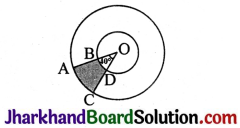
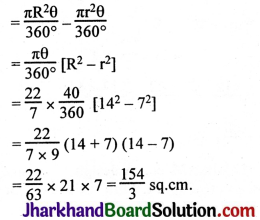

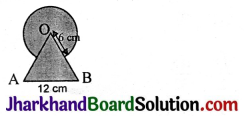
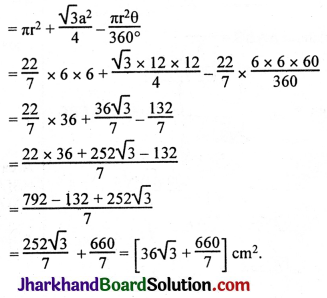
![]()

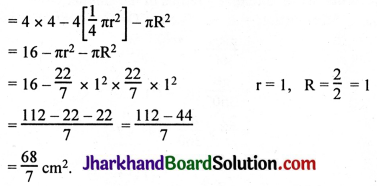

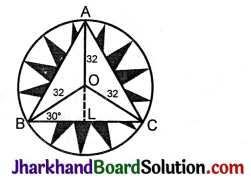

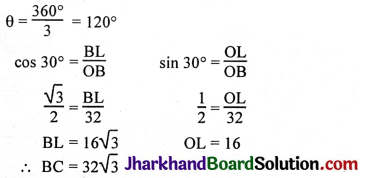

![]()

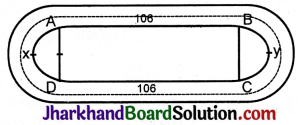
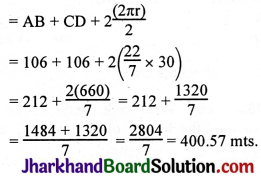
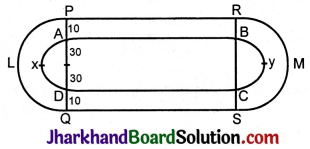


![]()

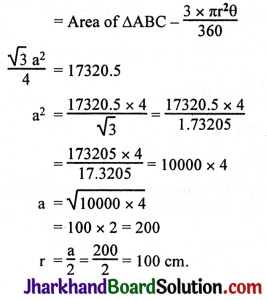

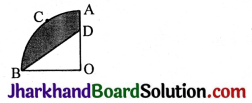


![]()



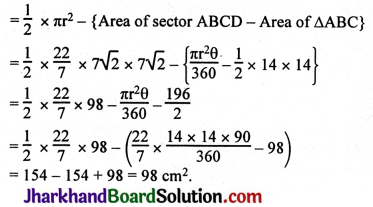
![]()
